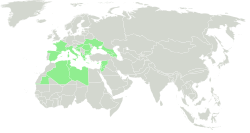Taxonomy Senecio leucanthemifolius was first described by Jean Louis Marie Poiret in 1789. [ 2] [ 3] As of April 2024 [ update] circumscription of the species varied. Euro+Med Plantbase took a wide view, whereas Plants of the World Online (PoWO) split it into a number of species. For example, Euro+Med Plantbase considered Senecio crassifolius Willd. to be a synonym, [ 1] while Plants of the World Online (PoWO) accepted it as a separate species. [ 4]
Subspecies As of April 2024 [ update] [ 1]
Senecio leucanthemifolius subsp. caucasicus (DC.) Greuter (also accepted by PoWO)Senecio leucanthemifolius subsp. cyrenaicus (E.A.Durand & Barratte) Greuter (=Senecio cyrenaicus (E.A.Durand & Barratte) Borzì in PoWO)Senecio leucanthemifolius subsp. leucanthemifolius Senecio leucanthemifolius subsp. mauritanicus (Pomel) Greuter (=Senecio fradinii Pomel in PoWO)Senecio leucanthemifolius subsp. vernalis (Waldst. & Kit.) Greuter (=Senecio vernalis Waldst. & Kit. in PoWO)Plants of the World Online accepted two further subspecies: [ 3]
Senecio leucanthemifolius subsp. cossyrensis (Lojac.) C.Brullo & Brullo Senecio leucanthemifolius subsp. pectinatus (Guss.) C.Brullo & Brullo This page is based on this
Wikipedia article Text is available under the
CC BY-SA 4.0 license; additional terms may apply.
Images, videos and audio are available under their respective licenses.

